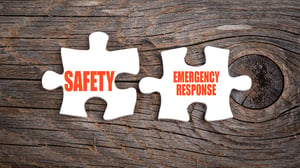During a recent ZeroNow Sessions roundtable with Jeff Kelly, the director of K12 Technology Solutions for Mutualink, Kim Marsh, the Director of Sales and Business Development for @Grav-IT / A.S.R.S.- The Active Shooter Response System, and Dana Lawhorne, the sheriff of the Alexandria Police Department, they discussed ways that technology can be used to increase communication, and help stop tragedies sooner. Read how you can use automated safety systems to make your school system or business safer for everyone involved or scroll to the bottom for a video replay of the event.

What is an Automated Safety System?
Essentially, it uses cameras, phones, panic buttons, and other types of technology to monitor school buildings, and alert emergency services sooner rather than later. This allows emergency services to act sooner, as we can observe what is going on in real-time instead of trying to piece things together after everything is over.
An automated emergency system also takes the human error out, because you no longer have to wait for someone to sound the alarm. This is because many people who aren't used to these types of situations panic. They may call 911, but then they're leaving out crucial information that law enforcement needs to know. If all they need to do is press a single button, which relays key information to emergency services, countless lives can be saved.
Four Tenants
There are four tenants that take place in an emergency situation, especially when it comes to keeping students safe on school campuses. These include threat assessments, mass notification, situational awareness, and reunification.
Threat Assessments
Threat assessments are used to determine what type of emergency is happening. It doesn't matter if it's an active school shooting, or if several people have been injured in an accident because it allows law enforcement and other emergency services to determine what course of action needs to take place next. It begins with those who are in the immediate vicinity and see what is going on, such as a masked individual approaching the school building with a gun. They can alert the authorities immediately, rather than waiting until the individual is in the building.
Mass Notification
Mass notification is when the authorities are alerted. Many school districts believe that the situation is now handled. That's not always the case, as there are still other factors to be taken into consideration.
Thanks to cell phones, students can contact their parents from inside the building. What they report to their loved ones may not be what's actually going on, and now you've got a group of scared parents swarming the building.
Mass notification, when used properly, can alert each person that needs to be in the loop automatically. This can prevent rumors from spreading, which could potentially make the situation worse.
Situational Awareness
Technology is used in schools to monitor what is going on, and communicate with those inside. This can include:
- Walkie-talkies
- Telephones
- Public address
- Video cameras
- Access control
These are activated by dialing three numbers on a phone or pressing a button located under a desk or somewhere else.
Reunification
This is using the technology at hand to communicate and coordinate between multiple agencies. When you have several groups that are all working towards the same goal but have no idea what the others are doing, it's only going to make things worse. With reunification, it gets everyone on the same page.
Mobilizing First Responders
Calling 911 is effective, but it can also be time-consuming. The average 911 call takes anywhere from two and a half to three and a half minutes. This may not seem like a long time, but during an emergency situation where lives are in danger, that's three minutes an active shooter can be in a school building.
Technology can be used to reach out to multiple law enforcement agencies at once, rather than someone having to call each agency at once. This takes the response time down from several minutes in which each agency is being contacted one at a time to seconds.
For example, if a school system is using an automated emergency response system, then the sheriff's office, fire department, local PD, and emergency management are all alerted simultaneously.
An automated system can also help emergency response teams go directly to the area of an accident, rather than having an EMS team wait for school personnel to meet them outside, and then guide them to the situation. It provides information such as:
- Type of emergency
- School name
- Address
- Teacher
- Room number
The types of automated technology used can include:
- Panic buttons
- Apps
- Fobs
- Telephones
Planning is Key
Having a rough idea of what will take place if there is an active shooter or another type of emergency is not enough. There are many things that can go wrong, and a simple practice session can help reveal some of these issues, so a plan can be made to deal with them.
To do this, a practice session with everyone involved, from law enforcement to EMS is crucial. This helps to make sure that everyone is on the same page so that one person doesn't assume that another agency is dealing with a situation when in reality no one is.
Where Can Automate Emergency Response Systems Be Used
We often think of schools, but there are other areas where these systems can be used. These can include:
- Hospitals
- Businesses
- Retail
- Manufacturing
- Corporate environments
Automated systems can also be used to connect multiple buildings, such as schools. If you have an active shooter at the elementary school, and there is a middle school down the road, then those at the middle school need to lock down immediately. An automated system can include the entire school system in the loop so that everyone can prepare in case something does happen.
Questions You Need to Ask When Checking Out Automated Emergency Response Systems
When you're ready to make the jump to an automated emergency response system, it's important to have an idea of what you want. Some questions you need to address with your team first include:
- What do you hope to achieve?
- How much money are you looking to invest?
- What type of technology do you want?
If you are interested in learning more about AI gun detection and our visual active shooter solution, check out these resources:

